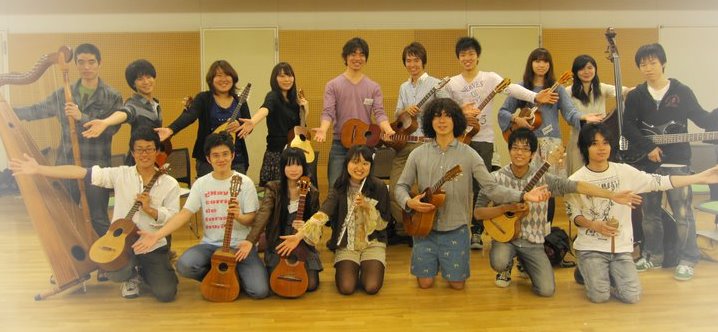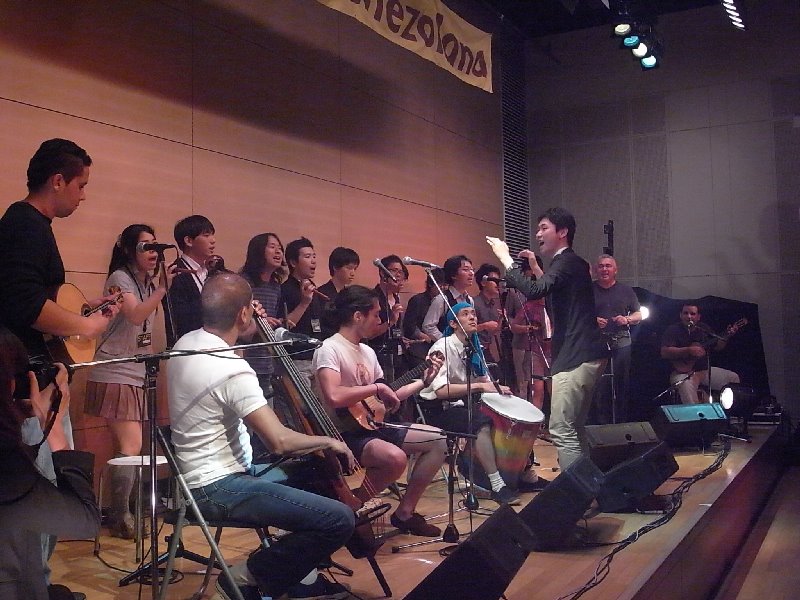This post, written in collaboration with Tomomi Sasaki, is part of a series on music as a bridge between Venezuela and Japan.
Have you ever wondered what interests Venezuelans and Japanese could have in common? If manga and sushi were your first guess, we invite you to explore how Japanese musicians have taken Venezuelan traditional music as the center of their interest, and how Venezuelan fans support and connect with these musicians using citizen media.
We kick off a short series of posts around this subject with some impressions coming from Japanese blogs about Venezuelan music. We will point out some conversations around the Estudiantina Komaba [jp], and continue with what bloggers in both Venezuela and Tokyo are saying about them. We will also explore conversations about other music artists using their blogs to share music and a lot more. At the end, we will see how music connects two countries that, until now, were believed to be far away from each other.

Image from Facebook group ‘Estudiantina Komaba Fans in Venezuela’, used with permission.
A video of the Estudiantina playing the very traditional Venezuelan song “Alma Llanera” became the center of conversation in blogs and tweets. Francisco Toro, in his blog “Caracas Chronicles”, got curious enough to contact the group and interview them online. Here's a piece of the interview [es] in which professor Jun Ishibashi, leader of the group, shares the story of the initiative :
[La] Estudiantina Komaba nace el 1 de agosto de 2009, al culminar el primer concierto de fin del Curso “Introdcción a la interpretación de la música latinoamericana” […]
Estudiantina Komaba la forman los egresados de la clase y los que tienen ganas de seguir tocando la música venezolana durante todo el año. […] La idea de dar clases de la prática de la música venezolana en una universidad japonesa nace tras más de 25 años de actividades del profesor Ishibashi para la difusión de la música venezolana fuera de su territorio original.A partir del 2006 la Universidad de Tokio ha sido visitada músicos altamente prestigiosos de Venezuela así como El Cuarteto con Huguette Contramaestre, Ensamble Gurrufío, Ricardo Sandoval y Mattias Collet, Leonard Jácome, Rafael “Pollo” Brito, Marco Granados y VNote Ensamble, Caracas Sincrónica, etre otros, en el marco de la Semana Cultural de Venezuela, organizada por la embajada venezolana en Tokio
The Estudiantina Komaba was born on August 1, 2009, after the year-ed concert of the course “Introduction to Venezuelan and Latin American Music” […] The Estudiantina is made up by musicians coming out of that course and also by those that wanted to keep playing Venezuelan music all year long […] The idea of teaching Venezuelan music in a Japanese university came after 25 years of professor Ishibashi's work in expanding Venezuelan music out of its original territory.
Since 2006 the University of Tokyo has been visited frequently by Venezuelan musicians of high prestige like El Cuarteto con Huguette Contramaestre, Ensamble Gurrufío, Ricardo Sandoval y Mattias Collet, Leonard Jácome, Rafael “Pollo” Brito, Marco Granados y VNote Ensamble, and Caracas Sincrónica, among others. It all happened inside the Venezuelan Cultural Week organized by the Venezuelan Embassy in Tokyo.
Furthermore, in Venezuela, fans of the Estudiantina created a Facebook group [es] where they share comments, videos, articles and pictures of the Estudiantina Komaba. In the bio, they explain the story of the group and some of its dynamics:
Los estudiantes aprenden unas 6 piezas cada semestre – joropos, valses, calipsos y orquidea, etc. Las piezas que aprenden en la clase son un punto de partida para la afición a la música venezolana para ellos.
The Estudiantina is not the only one interested in Venezuelan music. In his blog Café y Cuatros [jp], professor Yasuji Deguchi shares music sheets, tips and lyrics for those interested in playing Venezuelan traditional music.

Estudiantina Komaba with Venezuelan artist Cheo Hurtado. Image from Facebook group ‘Estudiantina Komaba Fans in Venezuela’, used with permission.
The exchanges taking place are growing and being shared on social media. Thanks to these conversations, we discover more and more Japanese artists taking Venezuelan music as their main repertoire and a Japanese public opening to Venezuelan sounds.
In our next post we'll explore what the Japanese blogosphere has said about Yoko Yoshizawa, a Japanese harpist specialized in Venezuelan “arpa”. For now, let's resume this exchange with Takuya Suzuki's post [jp], written during the Venezuelan cultural week. In the post, we can see how a local politician discovered sounds that ended up coming from an unexpected place :
素朴な音楽?なんて想像していたのですが、とんでもない。民族音楽とジャズが混ざり合い高い洗練度。リード楽器のマンドリンは広がりある旋律を紡ぎます。私は、ロック音楽をいつも聞いているので、米英に目が向きがちですが、世界は広い、豊かだな、と自らの視野の狭さを反省しました。







9 comments
Wonderful, it shows that music is the greatest way of connecting different cultures. One of the advantages of pronouncing the lyrics is that the phonetic sounds of Japanese and Spanish are very much the same. Bravo dear japanese friends, it is a great homage to the beauty of Venezuelan music.
Regards! The official facebook´s page of the Estudiantina Komaba is: http://www.facebook.com/EstudiantinaKomaba
Also, this is the Venezuelan Official fan page: http://www.facebook.com/estukomaba
Besides, In Twitter, the Official Twitter account is: @EstudiantinaKom ….Visit all of them and know the Estudiantina Komaba! (Jorge Perez, Venezuelan fan page’s designer)
Others ways to contact the Estudiantina Komaba are:
-Their official facebook account: http://www.facebook.com/EstudiantinaKomaba
-Venezuelan Official Fan Page: http://www.facebook.com/EstuKomaba
– Official EK Twitter: @EstudiantinaKom – EK Official Page: estudiantinakomaba.com/